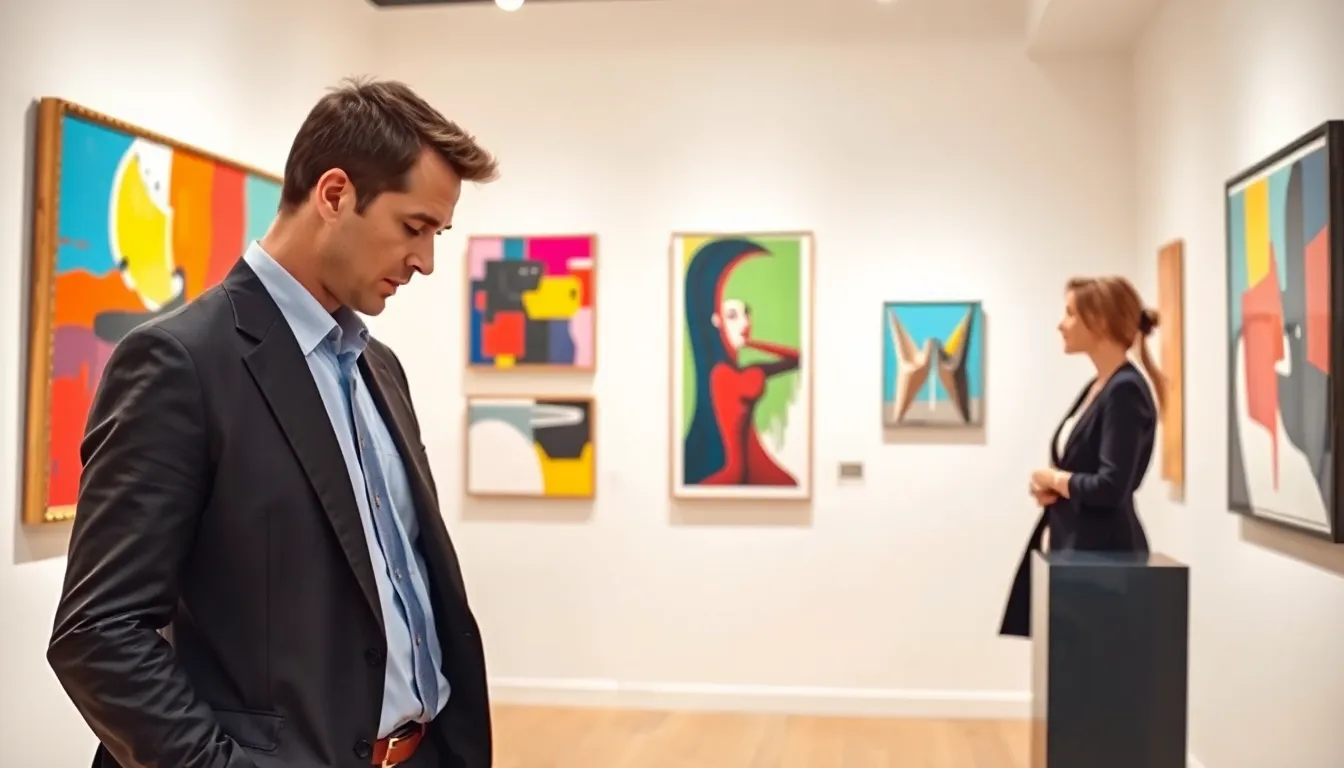In the world of modern art, a splash of color can hide more than just an artist’s genius. It can also mask a little something called money laundering. Who knew that a canvas splattered with paint could double as a disguise for illicit cash? As the art market skyrockets, so does its appeal to those looking to clean up their finances in the most avant-garde way possible.
Imagine a wealthy collector strolling through a gallery, casually dropping millions on a piece that looks like it was created during a particularly enthusiastic toddler’s art class. Little do they know, they might just be unwittingly participating in a high-stakes game of financial hide-and-seek. With the art world’s allure and its lack of transparency, the stage is set for a colorful cocktail of creativity and crime. Buckle up as we dive into the fascinating—and slightly absurd—intersection of modern art and money laundering.
Table of Contents
ToggleUnderstanding Modern Art Money Laundering
Modern art serves as a unique vehicle for money laundering, luring wealthy individuals into potentially illicit financial activities. The lack of regulation in the art market often creates opportunities for misuse.
Definition and Overview
Modern art money laundering involves using art transactions to conceal the origins of illegal funds. This process typically relies on high-value purchases of artwork to obscure financial activities. Art pieces often lack objective pricing, making it difficult to assess true value. Collectors can buy and sell art with limited scrutiny, allowing financial crime to flourish within the industry. This scenario raises concerns regarding transparency, ethics, and the integrity of the art market.
History and Evolution
The connection between art and money laundering has evolved over decades. In the 1970s, organized crime began exploiting art transactions for financial gain. Growth in the global art market during the 1980s intensified these practices. Regulatory measures were limited, allowing art dealers to facilitate questionable sales. More recently, high-profile auctions and private sales have attracted attention for inflated prices. The emergence of online platforms further complicates market dynamics, as anonymity increases with digital transactions. Overall, the art market’s evolution has created a favorable environment for money laundering.
Mechanisms of Money Laundering in Modern Art

Modern art serves as an attractive vehicle for laundering illicit funds. The vibrant nature of the art market, combined with its opacity, creates numerous mechanisms for financial crime.
Use of Art as an Asset
Art operates as a high-value asset, often appreciating over time. Art collectors frequently view pieces as long-term investments. High-value artworks can sell for millions, allowing substantial capital to move undetected. Buyers can acquire art without revealing financial sources, obscuring the origins of funds. This asset-driven approach facilitates the masking of illicit activities. When collectors sell or trade art, they solidify anonymity in transactions.
Role of Art Dealers and Galleries
Art dealers and galleries play a significant role in facilitating art transactions. Dealers often determine the value of artworks, contributing to subjective pricing. Galleries sometimes operate without adequate due diligence, allowing questionable transactions to occur. They may prioritize sales over ethical practices, inadvertently enabling money laundering schemes. In some cases, dealers act as intermediaries, further masking the identity of buyers and sellers. This lack of transparency allows for the integration of illicit money into the legitimate art market.
Notable Cases and Scandals
Numerous high-profile incidents illustrate the intersection of modern art and money laundering. In 2017, the case of the “Redmption” painting by Jean-Michel Basquiat gained attention. It sold for $110.5 million, drawing scrutiny regarding its ownership history. Reports suggested potential connections to drug trafficking and organized crime. Auction houses played a pivotal role, often facing criticism for lacking thorough background checks on buyers and sellers.
Legal consequences increasingly target those involved in these scandals. Art dealers and collectors find themselves under investigation as authorities heighten scrutiny. In the UK, a 2021 case resulted in a major art dealer receiving a hefty fine for facilitating suspicious transactions. The U.S. Department of Justice prosecutes cases involving substantial sums of money tied to art sales, sending a clear message about accountability. These legal actions underscore the need for greater transparency within the art market.
Impact on the Art Market
The implications of modern art money laundering significantly affect the art market. Illicit activities undermine trust and stability, making transparency essential for healthy transactions.
Market Manipulation
Market manipulation arises as collectors and dealers engage in inflated pricing to mask illegal financial activities. Art’s subjective valuation allows individuals to exaggerate prices, creating an illusion of value. Auction houses often play a pivotal role, leading to dramatic sales figures that can mislead potential buyers. Such instances create volatility, where genuine collectors face inflated competition. Unfortunately, these manipulative practices distort the perception of true market worth, complicating the judgment of quality and authenticity in art transactions. Wealthy buyers may inadvertently participate, further entrenching discrepancies in pricing and value assessment.
Trust and Transparency Issues
Trust issues plague the art market, particularly concerning the anonymity surrounding transactions. The lack of regulatory oversight fosters an environment ripe for deceit and fraud. Limited vetting processes for buyers and sellers often enable dubious deals, impacting the overall credibility of art sales. Furthermore, galleries might prioritize profit over due diligence, contributing to a culture of mistrust. The absence of comprehensive provenance records complicates matters, as potential buyers cannot ascertain the legitimacy of works. Consequently, transparency becomes vital for maintaining integrity in transactions, urging the need for heightened scrutiny within the industry.
Strategies for Prevention
Preventing modern art money laundering requires targeted efforts across various sectors, primarily emphasizing robust regulatory measures and educating art collectors.
Regulatory Frameworks
Strengthening regulatory frameworks can significantly curb money laundering in the art market. Governments must implement strict laws that mandate thorough due diligence on art transactions. Legal requirements for provenance documentation ensure buyers understand the history and ownership of artworks. International cooperation adds another layer by uniting jurisdictions to tackle illicit activities effectively. Agencies must collaborate, sharing intelligence and risk assessments on high-value transactions. Enforcing penalties for non-compliance will deter unethical practices and promote transparency within the market.
Best Practices for Art Collectors
Adopting best practices is essential for art collectors aiming to engage responsibly. Collectors should conduct extensive research on artworks before making acquisitions. Verifying provenance through credible sources minimizes the risk of unknowingly participating in money laundering. Utilizing trusted dealers establishes a solid foundation for ethical buying. Additionally, keeping detailed records of purchases, including invoices and certificates of authenticity, builds transparency and accountability. Engaging in art fairs and exhibitions can further enhance knowledge and connections, fostering a more informed art community.
The intricate relationship between modern art and money laundering underscores a pressing need for reform within the art market. As illicit activities continue to exploit the sector’s opacity the integrity of art transactions hangs in the balance. Strengthening regulations and promoting transparency are essential steps to safeguard the market against financial crimes.
Art collectors must remain vigilant and informed to navigate this complex landscape. By prioritizing provenance and ethical practices they can contribute to restoring trust and stability in the art world. The fusion of creativity and commerce should inspire admiration not suspicion. Moving forward the art community must unite in the pursuit of accountability and integrity to ensure a vibrant and legitimate marketplace.


